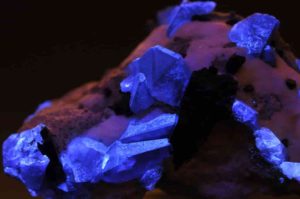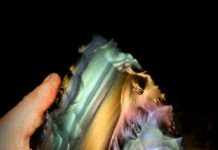
What is Benitoite Mineral?
Benitoite is a rare minerals best known to be the official Californian state gemstone. It is a barium titanium silicate mineral, typically of a blue color, found in hydrothermal rocks with a chemical composition of Ba Ti(Si 3O9). It is an extremely rare rock.
It is an extremely rare titanium cyclosilicate blue barium found in serpentinite that has been altered hydrothermally. This forms environments characteristic of subduction zones at convergent plate boundaries in low temperature, high pressure settings. Under short wave ultraviolet light, benitoite fluoresces which appear bright blue to bluish white in colour. Under long-wave UV light, the clearer to white benitoite crystals fluoresce green.
It was discovered about halfway between San Francisco and Los Angeles by prospector James M. Couch in the San Benito Mountains in 1907. Originally, Couch assumed that the mineral was a corundum mineral called sapphire because of its color similarity. A specimen was sent to the University of California, Berkeley in 1909 where mineralogist Dr. George D. Louderback discovered it was a mineral that was previously unknown. Corundum (sapphire) has a Mohs hardness specified at 9, while benitoite is much softer. He named it benitoite for its occurrence near the headwaters of the San Benito River in San Benito County, California.
It occurs globally in a variety of isolated locations, but only in California at the Benito Gem Mine where it was first discovered was gemstone quality material found. It has been correctly identified in Montana, Arkansas, Japan, and Australia even though they have evolved under slightly different conditions and are only increasing large enough to be considered a mineral accessory. Benitoite was named California’s official state gem in 1985.
It has a rare twinned crystal shape of 5 points, and an even rarer twinned crystal shape of 6 points, “David’s star,” with precisely 24 known specimens making it more precious than diamonds.
Physical Characteristics of Benitoite
Color: is typically blue, but also colorless and yellowish.
Luster: is vitreous.
Transparency: Crystals are transparent to translucent.
Cleavage: is absent.
Fracture: is irregular.
Hardness: is 6 – 6.5
Specific Gravity: is approximately 3.6 (above average)
Streak: is white
How is Benitoite formed?
It occurs only in the most mineralized region of California, the New Idria Mining District, in San Benito Country / USA (more than 150 semi-precious minerals and gemstones). There is a mountain range of basalt, chert, gray wack, shale, serpentine and Cretan and Tertiarian sandstones at the southern end or at the “Diablus Range.” It is a mountainous belt. Benitoite crystals have been formed from hydrothermal solutions containing relatively high levels of rare components such as barium, titanium, fluorine, iron etc. The minerals Albite, joaquinite, natrolite, neptunite and serpentine occur mainly with this. Natrolite, the last mineral produced at the deposit of benitoite, covered all of that deposit’s minerals. It is therefore necessary to remove the natrolite with acid (HCl) to expose the crystals of benitoite.
Where can benitoite be found?
Typically, benitoite occurs in combination with minerals which make up the host rock. The most widely used minerals are: natrolite, neptunite, joaquinite, serpentine and albite.
It is a rare mineral found in very few areas, including California, San Benito County, Japan and Arkansas. In the event of San Benito, it is contained in natural veins in a serpentinite body in glaucophane schists. The Mineral in Japan occurs on a dike cutting a serpentinite body of magnesio-riebeckite-quartz-phlogopite.
Where can I find Benitoite in California?
The Gem Benitoite mine is located about halfway between Los Angeles and San Francisco and has a small mining claim (Dallas claim) in San Benito County, California.
Why is benitoite a state gem in california?
Benitite was designated the official staple in 1985 by California.
It often referred to as the “blue diamond,” a very rare gem that varies in its hue, from light transparent to dark blue, to saphire blue or sometimes violet shad, which was found first on San Benito River headwater in 1907 (which is why the name is named).
It (pronounced as “benee-toe-ite”) was initially considered a saphire, but was found to be a science new mineral after careful analysis. Benitoite crystals of value are only found in California.
How much is Benitoite worth?
This gem is quite expensive Rich blue, clean stones at a carat and above sizes will command high prices. Clarity improves quality, particularly eye clean or better scores. Very light and very dark rocks lie at the lower end of the price continuum. At the top, you’ll find medium-dark stones.
Benitoite – $4,000 per carat
What is Benitoite used for?
Benitoite is used for a number of different purposes
- The precious rock is used to produce jewellery as a gemstone.
- Benitoite is another important use as a mineral sample. The mineral’s unique crystals are of great value as collectable samples.
- This is also used as a small barium and titanium deposit.
How do you identify Benitoite?
This occurs in low temperature, high-pressure conditions typical of subduction zones at the edge of the converging plate. Under short wave ultraviolet light, benitoite fluoresces which appear bright blue to bluish white in colour. Under long-wave UV light, the clearer to white benitoite crystals fluoresce green.










